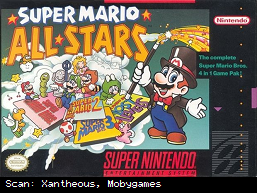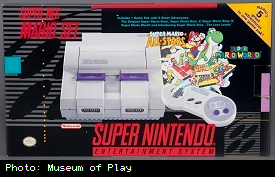~~~~~~~~~~~~~~~ SuperForeverCom ~~~~~~~~~~~~~~~
~~~~~~~~~~~~~~ the Super NES fansite ~~~~~~~~~~~~~~
QUICK NAVIGATION
| HOME | ABOUT | GAMES | PAGES | PLAYLISTS | MIDI FILES | EMULATION |
GALLERY |
~~~~~~~~~~~~~~~~~~~~~~~~~~~~~~~~~~~~~~~~~~~~~~~~~~~~~~~~~~~~~~~~~~~~~~~~~~~~~~~~~~~~
SUPER MARIO ALL-STARS
Nintendo EAD, 1993


Release Date (standard edition): August 1993
Release Date (+Super Mario World): December 1994
Other Platforms: Wii (as "Super Mario All-Stars 25th Anniversary Edition"), Nintendo Switch Online
Developer: Nintendo Entertainment Analysis & Development, based upon work by Nintendo R&D4
Publisher: Nintendo
Special Considerations: Called "Super Mario Collection" in Japan; packed-in software; compilation/shovelware
The NES Mario games, revamped for the '90s! Super Mario All-Stars was a next-gen re-release of three
NES games (and one Famicom game), using the high-colour graphics and PCM sampled sound of the
Super NES. Specifically, Super Mario All-Stars remastered all three Super Mario Bros. series games, plus
the Famicom game, Super Mario Bros. 2, which is referred to here as The Lost Levels.
SUPER MARIO BROS. 2 (disambiguation)
The NES game called Super Mario Bros. 2 had not been released in Japan until after the Super Famicom,
at which time it was called Super Mario Bros. USA. What was called Super Mario Bros. 2 in the rest of the
world had originally been a licensed game based upon the anime Yume Koujou, called Yume Koujou:
Dokidoki Panikku. Since the license didn't carry outside Japan (and probably would have made no sense
anyway, as Yume Koujou was never released anywhere else), Nintendo replaced the setting with SubCon
and the main characters with Mario & Friends for the overseas release.
The Famicom game, Super Mario Bros. 2, was an officially-created re-map mod of Super Mario Bros.
Sort of like the Doom II of its day, Super Mario Bros. 2 was designed to be more of a challenge for people
who had beaten Super Mario Bros. While Nintendo of America did give this version a test go, it was decided
that it was so difficult, players would discount the game as impossible to complete; something that was
fairly common in home computer games and one of the causes of the 1983 Atari shock. Unlike the NES game
called Super Mario Bros. 2, which was eventually released in Japan, the Famicom Super Mario Bros. 2 was
never released in North America or Europe. At least, not on the NES, anyway. It was included in Super
Mario All-Stars as something of a flex on players who claimed to be Super Mario Bros. experts. It turned
out to be a flex on the developers, as well; Naoki Mori, the Super Mario All-Stars lead designer, chose not to
debug The Lost Levels, feeling it was too difficult (the foundational code for The Lost Levels' remake is
fairly close to the Super Mario Bros. remake, meaning he could still debug it in some roundabout manner).
THE GAMES
As stated before, Super Mario All-Stars consisted of 4 (or 5) games in a single cartridge.
Super Mario Bros.
Super Mario Bros: The Lost Levels
Super Mario Bros. 2
Super Mario Bros. 3
Following the Super NES cartridge redesign, and Nintendo of America's decision to stop packing
Super Mario World in with the Super NES control deck, Super Mario All-Stars was re-imagined, adding
Super Mario World as the 5th game in the anthology. This version of the anthology was never released
Japan, though it was released in Europe.
REMOVAL OF MINUS WORLD
The infamous "World -1" in Super Mario Bros. was patched out of the Super Mario All-Stars remake.
The glitch was made possible because Mario and Luigi had hitboxes only on their feet. Thus, if the player
faced away from the wall while jumping, jumped to a location where their rear-foot hitbox would register
collision with the top of one of the blocks in the wall, then crouch as soon as collision was detected, they
could fool the game into allowing them to enter a solid wall. In the remake, Mario and Luigi's hitboxes
were increased to cover their entire sprite, making the glitch difficult to perform. Moreover, in the case
that a player actually was able to enter the wall in the same fashion, the pipe behaviour was changed, so
that entering the leftmost pipe would simply transport the player to World 4-1 as normal.
CHANGES TO SUPER MARIO WORLD

The only major change to the Super Mario All-Stars version of Super Mario World was Luigi, whose sprite
sheet was made unique from Mario (in the original Super Mario World, Luigi was just a green clone of
Mario). While Luigi seemed to gain some new abilities-- such as sliding down hills on his knees and spitting
fireballs from his mouth-- it didn't affect gameplay at all. The only other changes made to the game were
some minor bugfixes and the addition of a fourth battery-save slot.
LEGACY
Beginning in 2001, Super Mario All-Stars was used as the basis for the Super Mario Advance series on the
Game Boy Advance. Only Super Mario Bros. 2 and 3 were ever released on the platform, as Nintendo had
recently re-released the original Super Mario Bros. under the title Super Mario Bros. Deluxe for the Game
Boy Color. The Super Mario Advance versions of the SMAS remakes gained a remake of the 1983 arcade
game, Mario Bros. They also featured voice acting, from Charles Martinet and Jen Taylor.
The standalone version of Super Mario All-Stars was re-released on Wii for the 25th anniversary of Super
Mario Bros. in 2010, and again in 2020 for the 35th anniversary on Nintendo Switch Online.
Super Mario All-Stars + Super Mario World, however, has never been re-released. We can reasonably assume
this is because Nintendo would rather you buy twice (Super Mario World, then Super Mario All-Stars).
This has effectively caused Luigi's revised Super Mario World sprites to become exctinct.
COOL STUFF
Watch the games in action:
 Super Mario
All-Stars
Super Mario
All-Stars
 Super Mario World
Super Mario World
Listen to the soundtrack:
 Super Mario All-Stars
Super Mario All-Stars
 Super Mario World
Super Mario World
~~~~~~~~~~~~~~~~~~~~~~~~~~~~~~~~~~~~~~~~~~~~~~~~~~~~~~~~~~~~~~~~~~~~~~~~~~~~~~~~~~~~
Copyright © 2003-2022 Tina Rosenthal. The code is pretty basic, but it's mine. Don't get any ideas, now!